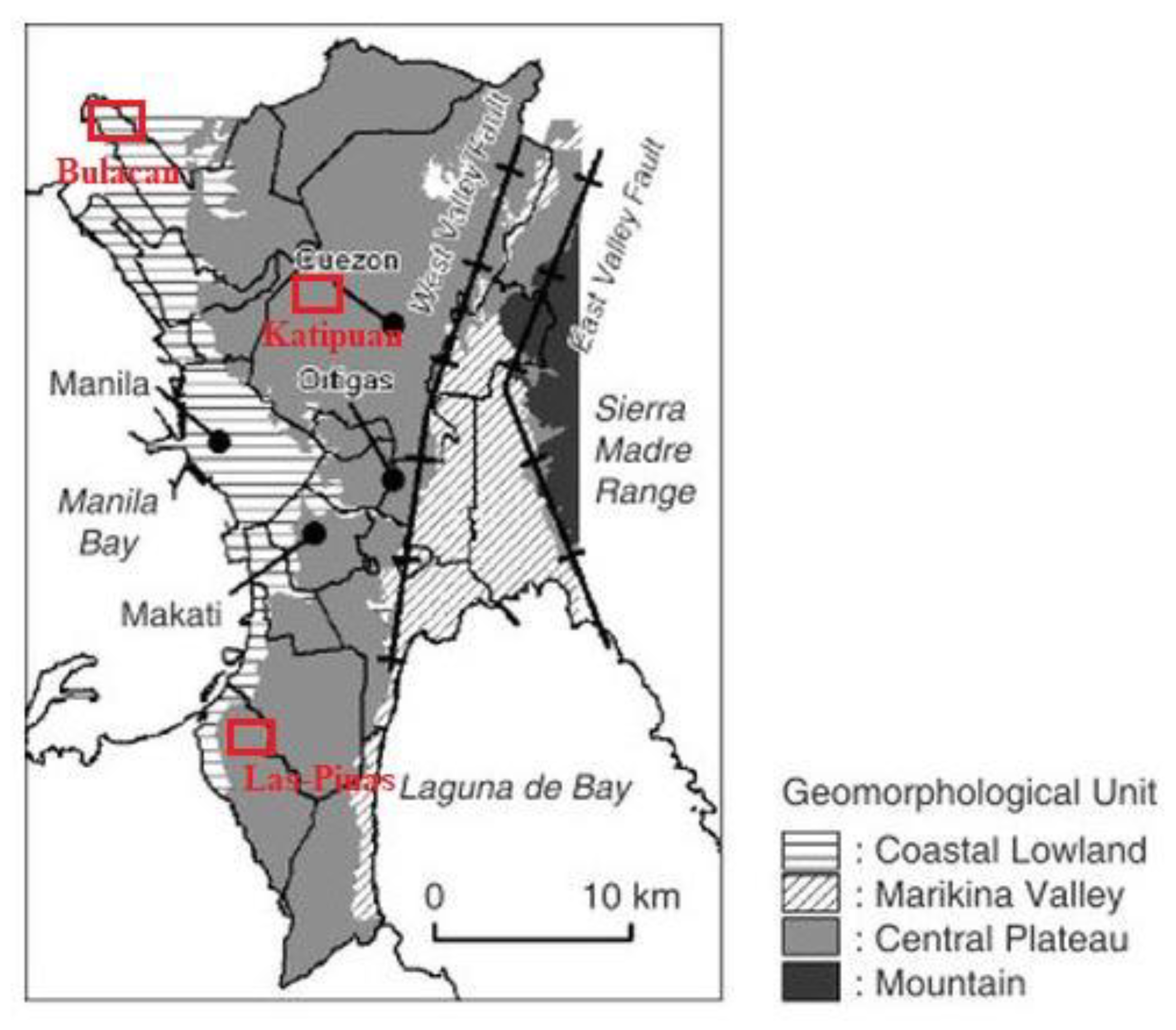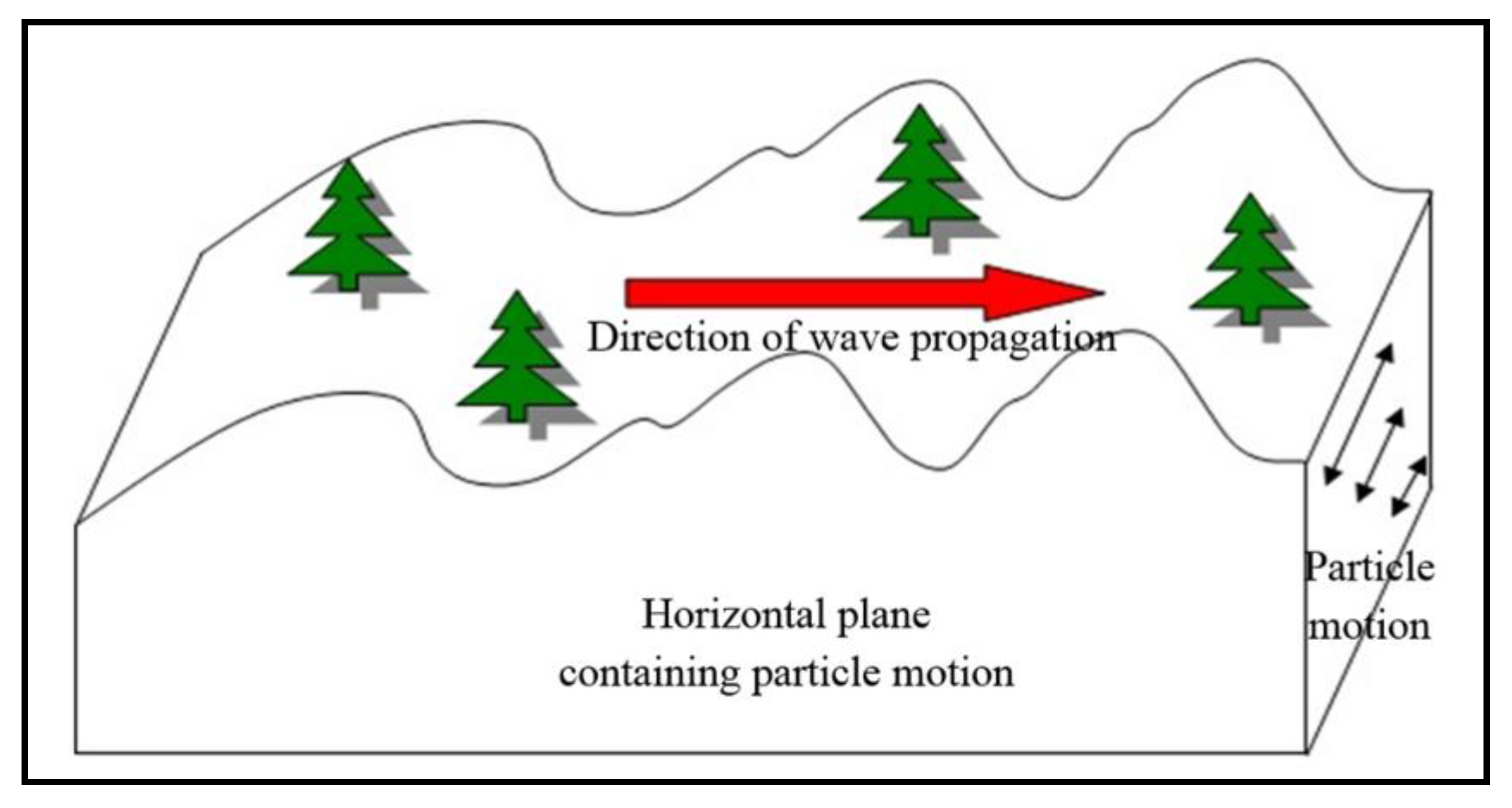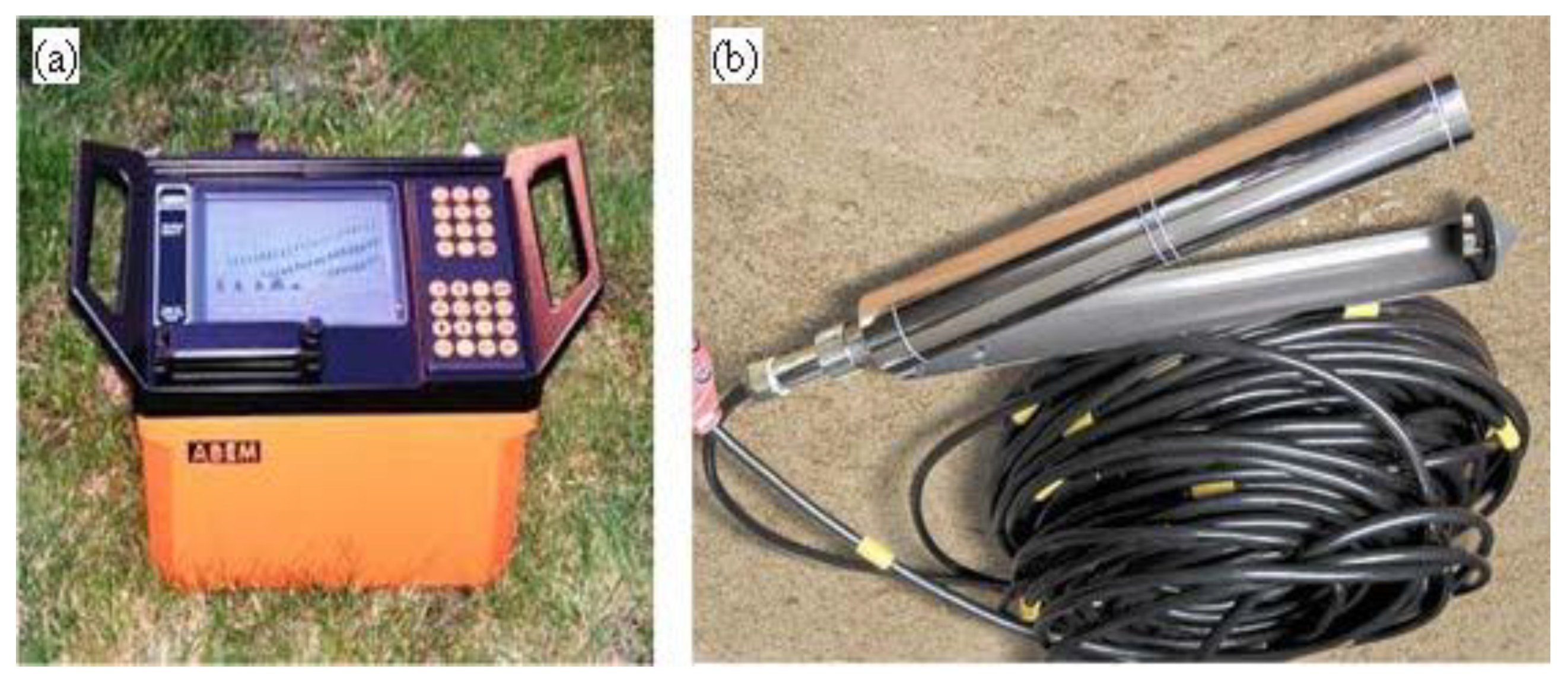Machine Learning Classifiers for Modeling Soil Characteristics by Geophysics Investigations: A Comparative Study
Abstract
1. Introduction
2. Materials and Methods
2.1. Description of DT Algorithms
2.2. ANN Algorithms
2.3. BN Algorithms
2.4. Case Study and Data Collection
2.5. Downhole Seismic Method
2.5.1. Seismic Waves
2.5.2. Body Waves
2.5.3. Surface Waves
2.5.4. Data Acquisitions
2.6. Laboratory Testing
2.6.1. Analysis of the Soil Particle Size
2.6.2. Atterberg Limits
2.6.3. Moisture Content of Soils (ASTM D 2216-98)
2.6.4. Soil Specific Gravity
2.7. Input and Output Parameters
3. Results
3.1. Models Stability
3.2. Importance of Variables
4. Discussion and Conclusions
Author Contributions
Funding
Acknowledgments
Conflicts of Interest
References
- Massarsch, K.R. The practical application of seismic testing in geotechnical engineering. Studia Geotech. Mech. 2007, 29, 121–135. [Google Scholar]
- Patrick, J.M. Digital Borehole Logging Instrumentation and Software, a Systems Approach to Design and Implementation. In Symposium on the Application of Geophysics to Engineering and Environmental Problems 1990; Society of Exploration Geophysicists; European Association of Geoscientists & Engineers: Houten, The Netherlands, 1990; pp. 155–168. [Google Scholar]
- Imai, T.; Tonouchi, K. Correlation of N-value with S-wave velocity and shear modulus. In Proceedings of the 2nd European Symposium of Penetration Testing, Amsterdam, The Netherlands, 24–27 May 1982; pp. 67–72. [Google Scholar]
- Kaneko, F.; Kanemori, T.; Tonouchi, K. Low-frequency shear wave logging in unconsolidated formations for geotechnical applications. In Geophysical Applications for Geotechnical Investigations; ASTM International: West Conshohocken, PA, USA, 1990. [Google Scholar]
- Bery, A.A.; Saad, R. Correlation of seismic P-wave velocities with engineering parameters (N value and rock quality) for tropical environmental study. Int. J. Geosci. 2012, 3, 749. [Google Scholar] [CrossRef]
- Karaman, K.; Kesimal, A. Correlation of Schmidt rebound hardness with uniaxial compressive strength and P-wave velocity of rock materials. Arab. J. Sci. Eng. 2015, 40, 1897–1906. [Google Scholar] [CrossRef]
- Patel, A.; Bartake, P.P.; Singh, D.N. An empirical relationship for determining shear wave velocity in granular materials accounting for grain morphology. Geotech. Test. J. 2008, 32, 1–10. [Google Scholar]
- Lau, K.C. A Review of Downhole Geophysical Methods for Ground Investigation; Technical Note No. TN 4/98; Geotechnical Engineer Office Hong Kong: Hong Kong, China, 1998.
- Ulusay, R.; Hudson, J.A. ISRM (2007) The Complete ISRM Suggested Methods for Rock Characterization, Testing and Monitoring: 1974–2006; ISRM Turkish National Group: Ankara, Turkey, 2007; 628p. [Google Scholar]
- Harlianto, P.A.; Adji, T.B.; Setiawan, N.A. Comparison of machine learning algorithms for soil type classification. In Proceedings of the 2017 3rd International Conference on Science and Technology-Computer (ICST), Yogyakarta, Indonesia, 11–12 July 2017; pp. 7–10. [Google Scholar]
- Van der Baan, M.; Jutten, C. Neural networks in geophysical applications. Geophysics 2000, 65, 1032–1047. [Google Scholar] [CrossRef]
- Aghaabbasi, M.; Shekari, Z.A.; Shah, M.Z.; Olakunle, O.; Armaghani, D.J.; Moeinaddini, M. Predicting the use frequency of ride-sourcing by off-campus university students through random forest and Bayesian network techniques. Transp. Res. Part A Policy Pract. 2020, 136, 262–281. [Google Scholar] [CrossRef]
- Azizi, A.; Seifipour, N. Modeling of dermal wound healing-remodeling phase by Neural Networks. In Proceedings of the Computer Science and Information Technology-Spring Conference, Singapore, 17–20 April 2009; pp. 447–450. [Google Scholar]
- Azizi, A. Applications of Artificial Intelligence Techniques in Industry 4.0; Springer: Singapore, 2019. [Google Scholar]
- Parisi, A.; Parisi, F.; Díaz, D. Forecasting gold price changes: Rolling and recursive neural network models. J. Multinatl. Financ. Manag. 2008, 18, 477–487. [Google Scholar] [CrossRef]
- Hajihassani, M.; Abdullah, S.S.; Asteris, P.G.; Armaghani, D.J. A Gene Expression Programming Model for Predicting Tunnel Convergence. Appl. Sci. 2019, 9, 4650. [Google Scholar] [CrossRef]
- Chen, H.; Asteris, P.G.; Jahed Armaghani, D.; Gordan, B.; Pham, B.T. Assessing Dynamic Conditions of the Retaining Wall: Developing Two Hybrid Intelligent Models. Appl. Sci. 2019, 9, 1042. [Google Scholar] [CrossRef]
- Asteris, P.G.; Moropoulou, A.; Skentou, A.D.; Apostolopoulou, M.; Mohebkhah, A.; Cavaleri, L.; Rodrigues, H.; Varum, H. Stochastic Vulnerability Assessment of Masonry Structures: Concepts, Modeling and Restoration Aspects. Appl. Sci. 2019, 9, 243. [Google Scholar] [CrossRef]
- Huang, L.; Asteris, P.G.; Koopialipoor, M.; Armaghani, D.J.; Tahir, M.M. Invasive Weed Optimization Technique-Based ANN to the Prediction of Rock Tensile Strength. Appl. Sci. 2019, 9, 5372. [Google Scholar] [CrossRef]
- Armaghani, D.J.; Asteris, P.G.; Fatemi, S.A.; Hasanipanah, M.; Tarinejad, R.; Rashid, A.S.A.; Huynh, V. Van On the Use of Neuro-Swarm System to Forecast the Pile Settlement. Appl. Sci. 2020, 10, 1904. [Google Scholar] [CrossRef]
- Apostolopoulou, M.; Asteris, P.G.; Armaghani, D.J.; Douvika, M.G.; Lourenço, P.B.; Cavaleri, L.; Bakolas, A.; Moropoulou, A. Mapping and holistic design of natural hydraulic lime mortars. Cem. Concr. Res. 2020, 136, 106167. [Google Scholar] [CrossRef]
- Sarir, P.; Chen, J.; Asteris, P.G.; Armaghani, D.J.; Tahir, M.M. Developing GEP tree-based, neuro-swarm, and whale optimization models for evaluation of bearing capacity of concrete-filled steel tube columns. Eng. Comput. 2019. [Google Scholar] [CrossRef]
- Asteris, P.G.; Armaghani, D.J.; Hatzigeorgiou, G.D.; Karayannis, C.G.; Pilakoutas, K. Predicting the shear strength of reinforced concrete beams using Artificial Neural Networks. Comput. Concr. 2019, 24, 469–488. [Google Scholar]
- Asteris, P.G.; Plevris, V. Anisotropic masonry failure criterion using artificial neural networks. Neural Comput. Appl. 2017, 28, 2207–2229. [Google Scholar]
- Asteris, P.G.; Nikoo, M. Artificial bee colony-based neural network for the prediction of the fundamental period of infilled frame structures. Neural Comput. Appl. 2019. [Google Scholar] [CrossRef]
- Armaghani, D.J.; Hatzigeorgiou, G.D.; Karamani, C.; Skentou, A.; Zoumpoulaki, I.; Asteris, P.G. Soft computing-based techniques for concrete beams shear strength. Procedia Struct. Integr. 2019, 17, 924–933. [Google Scholar] [CrossRef]
- Apostolopoulour, M.; Douvika, M.G.; Kanellopoulos, I.N.; Moropoulou, A.; Asteris, P.G. Prediction of Compressive Strength of Mortars using Artificial Neural Networks. In Proceedings of the 1st International Conference TMM_CH, Transdisciplinary Multispectral Modelling and Cooperation for the Preservation of Cultural Heritage, Athens, Greece, 10–13 October 2018; pp. 10–13. [Google Scholar]
- Peng, K.; Wang, Y.; Zou, Q.; Liu, Z.; Mou, J. Effect of crack angles on energy characteristics of sandstones under a complex stress path. Eng. Fract. Mech. 2019, 218, 106577. [Google Scholar] [CrossRef]
- Peng, K.; Zhou, J.; Zou, Q.; Song, X. Effect of loading frequency on the deformation behaviours of sandstones subjected to cyclic loads and its underlying mechanism. Int. J. Fatigue 2020, 131, 105349. [Google Scholar] [CrossRef]
- Zhou, W.; Shi, X.; Lu, X.; Qi, C.; Luan, B.; Liu, F. The mechanical and microstructural properties of refuse mudstone-GGBS-red mud based geopolymer composites made with sand. Constr. Build. Mater. 2020, 253, 119193. [Google Scholar] [CrossRef]
- Peng, K.; Zhou, J.; Zou, Q.; Yan, F. Deformation characteristics of sandstones during cyclic loading and unloading with varying lower limits of stress under different confining pressures. Int. J. Fatigue 2019, 127, 82–100. [Google Scholar] [CrossRef]
- Qi, C.; Fourie, A. Cemented paste backfill for mineral tailings management: Review and future perspectives. Miner. Eng. 2019, 144, 106025. [Google Scholar] [CrossRef]
- Qi, C.; Chen, Q.; Kim, S.S. Integrated and intelligent design framework for cemented paste backfill: A combination of robust machine learning modelling and multi-objective optimization. Miner. Eng. 2020, 155, 106422. [Google Scholar] [CrossRef]
- Qi, C.; Fourie, A.; Chen, Q. Neural network and particle swarm optimization for predicting the unconfined compressive strength of cemented paste backfill. Constr. Build. Mater. 2018, 159, 473–478. [Google Scholar] [CrossRef]
- Kordjazi, A.; Pooya Nejad, F.; Jaksa, M.B. Prediction of load-carrying capacity of piles using a support vector machine and improved data collection. In Proceedings of the 12th Australia New Zealand Conference on Geomechanics, Wellington, New Zealand, 22–25 February 2015. [Google Scholar]
- Armaghani, D.J.; Mohamad, E.T.; Narayanasamy, M.S.; Narita, N.; Yagiz, S. Development of hybrid intelligent models for predicting TBM penetration rate in hard rock condition. Tunn. Undergr. Space Technol. 2017, 63, 29–43. [Google Scholar] [CrossRef]
- Zhou, J.; Li, X.; Mitri, H.S. Comparative performance of six supervised learning methods for the development of models of hard rock pillar stability prediction. Nat. Hazards 2015, 79, 291–316. [Google Scholar] [CrossRef]
- Zhou, J.; Li, E.; Yang, S.; Wang, M.; Shi, X.; Yao, S.; Mitri, H.S. Slope stability prediction for circular mode failure using gradient boosting machine approach based on an updated database of case histories. Saf. Sci. 2019, 118, 505–518. [Google Scholar] [CrossRef]
- Zhou, J.; Shi, X.; Li, X. Utilizing gradient boosted machine for the prediction of damage to residential structures owing to blasting vibrations of open pit mining. J. Vib. Control 2016, 22, 3986–3997. [Google Scholar] [CrossRef]
- Zhou, J.; Li, X.; Mitri, H.S. Evaluation method of rockburst: State-of-the-art literature review. Tunn. Undergr. Space Technol. 2018, 81, 632–659. [Google Scholar] [CrossRef]
- Yang, H.Q.; Xing, S.G.; Wang, Q.; Li, Z. Model test on the entrainment phenomenon and energy conversion mechanism of flow-like landslides. Eng. Geol. 2018, 239, 119–125. [Google Scholar] [CrossRef]
- Yang, H.Q.; Li, Z.; Jie, T.Q.; Zhang, Z.Q. Effects of joints on the cutting behavior of disc cutter running on the jointed rock mass. Tunn. Undergr. Space Technol. 2018, 81, 112–120. [Google Scholar] [CrossRef]
- Zhou, X.P.; Yang, H.Q. Micromechanical modeling of dynamic compressive responses of mesoscopic heterogenous brittle rock. Theor. Appl. Fract. Mech. 2007, 48, 1–20. [Google Scholar] [CrossRef]
- Yang, H.Q.; Zeng, Y.Y.; Lan, Y.F.; Zhou, X.P. Analysis of the excavation damaged zone around a tunnel accounting for geostress and unloading. Int. J. Rock Mech. Min. Sci. 2014, 69, 59–66. [Google Scholar] [CrossRef]
- Yang, H.Q.; Lan, Y.F.; Lu, L.; Zhou, X.P. A quasi-three-dimensional spring-deformable-block model for runout analysis of rapid landslide motion. Eng. Geol. 2015, 185, 20–32. [Google Scholar] [CrossRef]
- Zhou, J.; Li, X.; Mitri, H.S. Classification of rockburst in underground projects: Comparison of ten supervised learning methods. J. Comput. Civ. Eng. 2016, 30, 4016003. [Google Scholar] [CrossRef]
- Armaghani, D.J.; Koopialipoor, M.; Marto, A.; Yagiz, S. Application of several optimization techniques for estimating TBM advance rate in granitic rocks. J. Rock Mech. Geotech. Eng. 2019. [Google Scholar] [CrossRef]
- Momeni, E.; Armaghani, D.J.; Fatemi, S.A.; Nazir, R. Prediction of bearing capacity of thin-walled foundation: A simulation approach. Eng. Comput. 2018, 34, 319–327. [Google Scholar] [CrossRef]
- Momeni, E.; Dowlatshahi, M.B.; Omidinasab, F.; Maizir, H.; Armaghani, D.J. Gaussian Process Regression Technique to Estimate the Pile Bearing Capacity. Arab. J. Sci. Eng. 2020. [Google Scholar] [CrossRef]
- Barman, U.; Choudhury, R.D. Soil texture classification using multi class support vector machine. Inf. Process. Agric. 2020, 7, 318–332. [Google Scholar] [CrossRef]
- Bhattacharya, B.; Solomatine, D.P. Machine learning in soil classification. Neural Netw. 2006, 19, 186–195. [Google Scholar] [CrossRef]
- Brungard, C.W.; Boettinger, J.L.; Duniway, M.C.; Wills, S.A.; Edwards, T.C., Jr. Machine learning for predicting soil classes in three semi-arid landscapes. Geoderma 2015, 239, 68–83. [Google Scholar] [CrossRef]
- Guang, Y.; Shujun, Q.; Pengfei, C.; Yu, D.; Di, T. Rock and soil classification using PLS-DA and SVM combined with a laser-induced breakdown spectroscopy Library. Plasma Sci. Technol. 2015, 17, 656. [Google Scholar]
- Abraham, S.; Huynh, C.; Vu, H. Classification of soils into hydrologic groups using machine learning. Data 2020, 5, 2. [Google Scholar] [CrossRef]
- Rahman, S.A.Z.; Mitra, K.C.; Islam, S.M.M. Soil classification using machine learning methods and crop suggestion based on soil series. In Proceedings of the 2018 21st International Conference of Computer and Information Technology (ICCIT), Dhaka, Bangladesh, 21–23 December 2018; pp. 1–4. [Google Scholar]
- Malajner, M.; Gleich, D.; Planinsic, P. Soil type characterization for moisture estimation using machine learning and UWB-Time of Flight measurements. Measurement 2019, 146, 537–543. [Google Scholar] [CrossRef]
- Hengl, T.; Mendes de Jesus, J.; Heuvelink, G.B.M.; Ruiperez Gonzalez, M.; Kilibarda, M.; Blagotić, A.; Shangguan, W.; Wright, M.N.; Geng, X.; Bauer-Marschallinger, B. SoilGrids250m: Global gridded soil information based on machine learning. PLoS ONE 2017, 12, e0169748. [Google Scholar] [CrossRef]
- Massawe, B.H.J.; Subburayalu, S.K.; Kaaya, A.K.; Winowiecki, L.; Slater, B.K. Mapping numerically classified soil taxa in Kilombero Valley, Tanzania using machine learning. Geoderma 2018, 311, 143–148. [Google Scholar] [CrossRef]
- Kass, G. V An exploratory technique for investigating large quantities of categorical data. J. R. Stat. Soc. Ser. C Appl. Stat. 1980, 29, 119–127. [Google Scholar] [CrossRef]
- Breiman, L.; Friedman, J.H.; Olshen, R.A.; Stone, C.J. Classification and Regression Trees; Wadsworth & Brooks; CERN Library: Geneva, Switzerland, 1984. [Google Scholar]
- Loh, W.-Y.; Shih, Y.-S. Split selection methods for classification trees. Stat. Sin. 1997, 7, 815–840. [Google Scholar]
- Quinlan, J.R. C4. 5: Programs for Machine Learning; Kaufmann, M., Ed.; Elsevier: San Francisco, CA, USA, 1993; ISBN 0080500587. [Google Scholar]
- Kamavisdar, P.; Saluja, S.; Agrawal, S. A survey on image classification approaches and techniques. Int. J. Adv. Res. Comput. Commun. Eng. 2013, 2, 1005–1009. [Google Scholar]
- Liu, J.; Savenije, H.H.G.; Xu, J. Forecast of water demand in Weinan City in China using WDF-ANN model. Phys. Chem. Earth Parts A/B/C 2003, 28, 219–224. [Google Scholar] [CrossRef]
- Mohamad, E.T.; Armaghani, D.J.; Noorani, S.A.; Saad, R.; Alvi, S.V.; Abad, N.K. Prediction of flyrock in boulder blasting using artificial neural network. Electron. J. Geotech. Eng. 2012, 17, 2585–2595. [Google Scholar]
- Tonnizam Mohamad, E.; Hajihassani, M.; Jahed Armaghani, D.; Marto, A. Simulation of blasting-induced air overpressure by means of Artificial Neural Networks. Int. Rev. Model. Simul. 2012, 5, 2501–2506. [Google Scholar]
- Asteris, P.G.; Argyropoulos, I.; Cavaleri, L.; Rodrigues, H.; Varum, H.; Thomas, J.; Lourenço, P.B. Masonry compressive strength prediction using artificial neural networks. In Proceedings of the International Conference on Transdisciplinary Multispectral Modeling and Cooperation for the Preservation of Cultural Heritage, Athens, Greece, 10–13 October 2018; pp. 200–224. [Google Scholar]
- Asteris, P.; Roussis, P.; Douvika, M. Feed-forward neural network prediction of the mechanical properties of sandcrete materials. Sensors 2017, 17, 1344. [Google Scholar] [CrossRef]
- Xu, C.; Gordan, B.; Koopialipoor, M.; Armaghani, D.J.; Tahir, M.M.; Zhang, X. Improving Performance of Retaining Walls Under Dynamic Conditions Developing an Optimized ANN Based on Ant Colony Optimization Technique. IEEE Access 2019, 7, 94692–94700. [Google Scholar] [CrossRef]
- Kennedy, J. Particle swarm optimization. In Encyclopedia of Machine Learning; Springer: Berlin/Heidelberg, Germany, 2011; pp. 760–766. [Google Scholar]
- Madden, M.G. Evaluation of the performance of the markov blanket bayesian classifier algorithm. arXiv 2002, arXiv:cs/0211003. [Google Scholar]
- Friedman, N.; Geiger, D.; Goldszmidt, M. Bayesian network classifiers. Mach. Learn. 1997, 29, 131–163. [Google Scholar]
- Zheng, F.; Webb, G.I. Tree Augmented Naive Bayes; Springer: Boston, MA, USA, 2010. [Google Scholar] [CrossRef]
- Pearl, J. Probabilistic Reasoning in Intelligent Systems: Networks of Plausible Inference; Elsevier: Amsterdam, The Netherlands, 2014; ISBN 0080514898. [Google Scholar]
- Richter, C.F. Elementaty Seismology; Freeman: New York, NY, USA, 1958; ISBN 0716702118. [Google Scholar]
- Kim, D.S.; Bang, E.S.; Kim, W.C. Evaluation of various downhole data reduction methods for obtaining reliable VS profiles. Geotech. Test. J. 2004, 27, 585–597. [Google Scholar]
- Lambe, T.W.; Whitman, R.V. Soil Mechanics; John Wiley & Sons: Hoboken, NJ, USA, 1991; Volume 10, ISBN 0471511927. [Google Scholar]
- Guo, H.; Zhou, J.; Koopialipoor, M.; Armaghani, D.J.; Tahir, M.M. Deep neural network and whale optimization algorithm to assess flyrock induced by blasting. Eng. Comput. 2019. [Google Scholar] [CrossRef]














| Area with Casing | Area without Casing |
|---|---|
| Suspension PS * ++ | Suspension PS * |
| Crosshole Seismic * | Crosshole Seismic * |
| Parameter | Unite | Minimum Value | Maximum Value | Average Value | Standard Deviation Value |
|---|---|---|---|---|---|
| Vp | (m/s) | 321 | 4215 | 2225.44 | 1041.71 |
| Vs | (m/s) | 356 | 1893 | 1129.64 | 430.28 |
| MC | (%) | 20.02 | 59.9 | 34.85 | 13.19 |
| LL | (%) | 23 | 70 | 40.97 | 8.94 |
| PL | (%) | 4 | 42 | 14.71 | 7.41 |
| Gs | (g/cm3) | 1.82 | 2.81 | 2.63 | 0.15 |
| CHAID | CART | C5 | QUEST | ANNMLP | ANNRBF | BAYESIAN TAN | BAYESIAN MARKOV | |
|---|---|---|---|---|---|---|---|---|
| Training | 98.23% | 98.23 | 99.12 | 99.12 | 98.23 | 98.23 | 98.23 | 100 |
| Testing | 84.21% | 89.47 | 92.11 | 94.74 | 94.74 | 94.74 | 84.21 | 34.21 |
| Criterion | Formula | Assessment Focus |
|---|---|---|
| Recall | Effectiveness of a classifier to distinguish class labels | |
| Precision | Agreement of the data class labels with those of a classifier | |
| Ci is a class is true positive for Ci, is false positive, and is false negative | ||
| Train | Test | |||
|---|---|---|---|---|
| N | % | N | % | |
| Agree | 109 | 96.46 | 10 | 26.32 |
| Disagree | 4 | 3.54 | 28 | 73.68 |
| Total | 113 | 38 | ||
© 2020 by the authors. Licensee MDPI, Basel, Switzerland. This article is an open access article distributed under the terms and conditions of the Creative Commons Attribution (CC BY) license (http://creativecommons.org/licenses/by/4.0/).
Share and Cite
Lim, C.S.; Mohamad, E.T.; Motahari, M.R.; Armaghani, D.J.; Saad, R. Machine Learning Classifiers for Modeling Soil Characteristics by Geophysics Investigations: A Comparative Study. Appl. Sci. 2020, 10, 5734. https://doi.org/10.3390/app10175734
Lim CS, Mohamad ET, Motahari MR, Armaghani DJ, Saad R. Machine Learning Classifiers for Modeling Soil Characteristics by Geophysics Investigations: A Comparative Study. Applied Sciences. 2020; 10(17):5734. https://doi.org/10.3390/app10175734
Chicago/Turabian StyleLim, Chee Soon, Edy Tonnizam Mohamad, Mohammad Reza Motahari, Danial Jahed Armaghani, and Rosli Saad. 2020. "Machine Learning Classifiers for Modeling Soil Characteristics by Geophysics Investigations: A Comparative Study" Applied Sciences 10, no. 17: 5734. https://doi.org/10.3390/app10175734
APA StyleLim, C. S., Mohamad, E. T., Motahari, M. R., Armaghani, D. J., & Saad, R. (2020). Machine Learning Classifiers for Modeling Soil Characteristics by Geophysics Investigations: A Comparative Study. Applied Sciences, 10(17), 5734. https://doi.org/10.3390/app10175734





